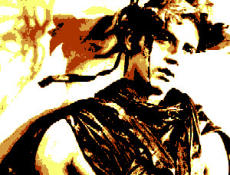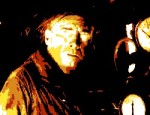Film Review

The film was financed by the wealthy French aristocrat Viscount Charles de Noailles, a notable patron of the arts who had recently bankrolled two scandalous surrealist films by Luis Buñuel and Salvador Dalí - Un chien andalou (1929) and L'Âge d'or (1930). Originally, De Noailles had wanted Cocteau to make an animated feature, but because the resources required to make such a film were not available to him, Cocteau offered to make a live action film that was just as liberated. With a budget of a million francs, and no prior filmmaking experience (apart from a 16 minute short, Jean Cocteau fait du cinéma which he made in 1925 and no longer exists), Cocteau launched himself into this production with a kind of manic glee, and would later describe it as the only film on which he felt fully able to express himself, unfettered by the constraints of commercial filmmaking. His intention was to express, primarily in visual terms, the torment of the artist as he strives and fails to express himself through the imperfect media at his disposal.
Like Georges Méliès and the other early pioneers of cinema before him, Cocteau was, by virtue of his inexperience, able to invent his own form of cinematic art, which was wildly different from anything seen by most cinema audiences at the time it was made. The end result may appear crude and primitive but it is breathtakingly original, an experimental film oddity that contains some of the most striking and disturbing imagery ever committed to celluloid. Like Méliès, the director he was perhaps most influenced by, Cocteau was guided only by his imagination and creative impulses, and his ingenuity more than makes up for his lack of experience.
Knowing nothing about camera tracking, Cocteau achieves a similar (but subtly different) result by mounting his actor on tracks and pulling him towards the camera. For some of the film's weirdest scenes, the walls are nailed to the floor and actor is dragged slowly across them, the action being shot from above by a ceiling-mounted camera. Both effects add to the unsettling dreamlike feel of the film, reminding us that cinema exists not only to show us the everyday world as we know it, but also to conjure up more fantastic landscapes of the imagination, where anything is possible. After all, what we see around us is only one reality out of an infinite number of possibilities. What cinema can, and should, do is to grant us access to some less familiar vistas, such as those that we visit in our dreams.
From this and his subsequent films, it is evident that Jean Cocteau regarded cinema as a medium of dreams, not reality. Le Sang d'un poète begins with a shot of a factory chimney about to collapse and ends with another of the same chimney stack tumbling down. The meaning is obvious: the entire action of the film takes places within a split second, as in a dream. The four segments of which the loose narrative is composed dovetail into one another, in a dreamlike-fashion, consisting of a succession of bizarrely surreal images that range from the eerily comedic to the downright horrific. That Cocteau was inspired by Buñuel's Un Chien anadalou is apparent in the first sequence, in which an artist's hand (his most precious possession) is violated by an unnatural breach. In Buñuel's film, ants emerge from a hole in the hand of the male protagonist. In Cocteau's film, the hand is desecrated by a mouth that has somehow transferred itself from a portrait - a succinct statement of an artist's indelible (and perhaps unwelcome) bond to his creations.
Cocteau's morbid preoccupation with death saturates the film and becomes its overriding theme. A schoolboy is killed when the school bully lobs a marble ball at him, causing him to vomit blood in copious quantities as he dies. Two male protagonists - a poet and a cardsharp - are impelled to put a bullet in their heads; one is unscathed, the other dies and spouts more blood, to the amusement of an assembled audience of bourgeois on-lookers. The artist's relationship with death is central to Cocteau's oeuvre, particularly his subsequent films Orphée (1950) and Le Testament d'Orphée (1969), which form a loose trilogy with Le Sang d'un poète.
Much of the stark iconography of Cocteau's first film reappears in his later features. The passage of the half-naked artist through a wall mirror into a dreamlike world which is difficult to navigate is reproduced almost verbatim in Orphée. The statue that comes to life (inspired by the Pygmalion myth) resurfaces in La Belle et la bête. The snowball fight in which a schoolboy is wounded by a lump of rock disguised as a snowball provides the sombre opening to Les Enfants terribles. And the shrouded mobile statue at the end of the film reminds us of the predatory Death Princess in Orphée. To those familiar with Cocteau's work, Le Sang d'un poète feels like a kind of artist's sketchpad which its author would continually return to whilst making his later films.
By the time Cocteau completed Le Sang d'un poète its patron, Charles de Noailles, was reeling under the public backlash to Buñuel's L'Âge d'or and was unwilling to risk further controversy. The film's release was consequently delayed for two years, by which time surrealism had virtually lost its power to shock. The Surrealists dismissed Cocteau's film as superficial, something which may have contributed to its author's reluctance to make another film. It was not until the mid-1940s, in the austere aftermath of the Second World War, that Jean Cocteau was motivated to make his next film, his masterful rendition of a perennial children's fairytale: La Belle et la bête (1946), a timeless classic of French cinema.
© James Travers 2013
The above content is owned by frenchfilms.org and must not be copied.
Film Synopsis
A factory chimney is just about to fall down... In May 1745, a bare-chested artist is painting a portrait of a woman. When the portrait's mouth suddenly comes to life, the artist attempts to erase it. But when he washes his hand in water he finds that it has acquired a scar - in the shape of a mouth! The artist manages to transfer the mouth to a statue, who then commands him to walk through a wall mirror. Doing so, he finds himself in a hotel corridor. Peeping through keyholes, he glimpses some bizarre sights, which include a Mexican being repeatedly shot dead by a firing squad, a little girl covered in bells crawling along a ceiling and a creepy hermaphrodite. Guided by a disembodied voice, the artist takes a gun and shoots himself in the head. Still alive, he returns to his own world and smashes the statue to pieces, only to become a statue himself, in a snow-covered school playground. Here, several schoolboys are happily throwing snowballs at each other. One boy is struck by a ball made of marble and dies. At a table placed beside the dead boy's body, a man plays cards with a beautiful young woman. The man takes a card from the boy's pocket, just before a dark-skinned angel appears and absorbs the boy's body. The card cheat then commits suicide with a gun. The woman is transformed into a moving statue and leaves the scene. The chimney stack suddenly collapses...© James Travers
The above content is owned by frenchfilms.org and must not be copied.
Similar Films
Here are some other films you may enjoy watching:- La Charrette fantôme (1939)
- Ugetsu monogatari (1953)
- Le Révélateur (1968)
- Je vous salue, Marie (1985)
- Teorema (1968)
Other related links:
Film Credits
- Director: Jean Cocteau
- Script: Jean Cocteau
- Cinematographer: Georges Périnal
- Music: Georges Auric
- Cast: Enrique Rivero (Poet), Elizabeth Lee Miller (Statue), Jean Desbordes (Louis XV Friend), Féral Benga (Black Angel), Pauline Carton, Odette Talazac, Fernand Dichamps, Lucien Jager, Barbette, Jean Cocteau
- Country: France
- Language: French
- Support: Black and White
- Runtime: 50 min
- Aka: The Blood of a Poet
The very best of French film comedy

The silent era of French cinema

The best of Russian cinema
